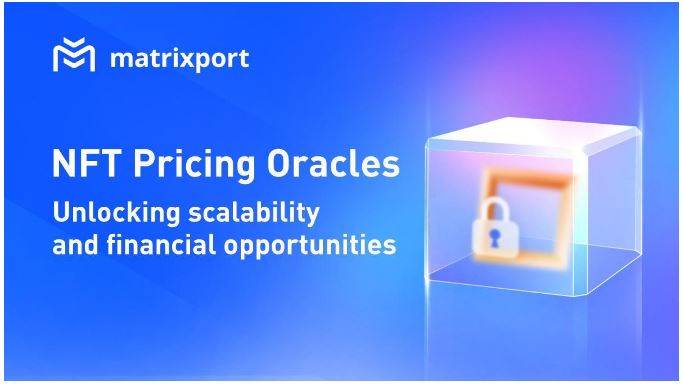Unlocking NFT scalability and financial opportunities with Matrixport
0
0

More than expensive digital art, NFTs are now rising to prove their utility as a digital asset.
The financialization of NFTs are enabling people to create financial opportunities by bundling NFTs to create indexes or using NFTs as collateral for lending and borrowing. However, there is a missing piece to realize the potential of this up-and-coming marketplace — NFT pricing.
Why do we need to put a price tag on NFTs?
Determining what an NFT is worth has always been a big unknown. Yet, being difficult does not mean that everyone should give up finding the right pricing oracle as it is the key to unlocking financial opportunities from NFTs.
Take the traditional art lending market for instance. Auction houses like Sotheby’s provide professional input on price through an auction process and, based on the determined price, art lending shops are able to provide better loan-to-value (LTV) ratios and interest rates.
We need a mechanism like the traditional art lending market, to better understand and agree upon the value of the NFTs to its financial primitives. With a reliable NFT price oracle, market players like NFT lending protocols will be able to produce attractive LTV ratios, interest rates, and duration of loans, resulting in a more efficient NFT lending market.
However, the usual methods for evaluating conventional assets aren’t really working out for NFTs simply due to its non-fungible core, leading to difficulty in generating continuous price information.
The journey to find ‘the pricing oracle’
The hope is not lost as many innovative pricing oracles are emerging in the NFT pricing landscape.
There is the likes of Upshot, which uses statistical analysis and machine learning to derive a value range for any NFTs based on historical trading data. Some would refer to on-chain Time-weighted Average Price (TWAP) on NFT floor prices from Chainlink or Sushiswap to build permissionless loan functions.
Others would leverage a curator committee incentivized by rewards by the final pricing session output, also known as Peer-to-Peer pricing by Taker Protocol. Last but not least, there are financial derivatives-driven primitives such as Abacus Spot, where participants can open pools, deposit ETH to speculate on NFT prices and track down NFT owners to activate emission rewards in the form of Abacus’ token.
In their attempt, existing approaches to value NFTs are, unfortunately, still fraught with potential hurdles — from the attack-prone method of time-weighted-average prices to laggy statistical machine learning techniques and inaccurate peer-appraisal models.
With this, it is clear that NFTs are in need of a new approach for valuation to unlock higher levels of scalability and accessibility of the whole NFT ecosystem. And the key is in creating a hybrid model of pricing oracles.
Creating synergy with a hybrid of pricing oracles
The combination of multiple NFT pricing approaches to enhance risk management and increase Loan-to-Value ratios would be the way forward for the protocols to grow the total value locked sustainably.
An example of this would be Bridgesplit’s ‘automated indexes’, which leverage its engineering capability and third-party solutions such as Abacus and Upshot to price NFTs and execute liquidation. To determine the collateral value of the NFT, real-time share prices of the fractionalized NFT pools are used instead of the pricing provided by the NFT oracle. The advantage of indexes like this is the open access to on-chain data.
Though their ability to counter potential NFT oracle attacks and the sustainability of liquidity on the liquidity pool-based lending protocols remains to be tested by the market, the combination of pricing oracles possesses the potential to provide more active price feeds for trading and enhanced levels of flexibility and scalability for participants in the ecosystem.
Matrixport in NFT
Matrixport, Asia’s fastest-growing digital assets financial services platform, and MetaOpus, a Non Fungible Token (NFT) asset issuance and trading platform powered by BlockCreateArt (BCA) Network, has announced a partnership to offer NFT investors best in class custody solutions. With this partnership, Matrixport will provide institutional-grade storage and protection measures for high-net-worth, institutional and retail investors.
In addition, Cactus Custody™, a qualified institutional custodian solution powered by Matrixport integrated with MetaMask Institutional (MMI) to support MMI’s multi-chain capabilities and EVM compatible chains. This feature called “DeFi Connector” offered by Cactus Custody enables institutional clients to seamlessly and securely interact their NFT with Dapp & NFT Marketplaces.
The dawn of NFT financialization
People often say NFTs are a thing of 2021. However, the NFT financialization landscape is proving this wrong.
With the industry innovation and development of innovative pricing oracles, we have the opportunity to pave the way to enhanced scalability and accessibility for NFTs, opening the door to onboard more participants to this burgeoning marketplace.
Click here to read more about NFT financialization, trends and opportunities, which will make this future a reality today.
Disclaimer: This is a paid post and should not be treated as news/advice.
The post Unlocking NFT scalability and financial opportunities with Matrixport appeared first on AMBCrypto.
0
0








